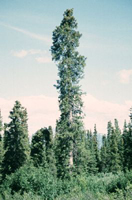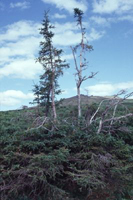Spruce growth forms at
treeline
| A "normal" spruce tree grows in an
upright, spire-shaped form like those in the photograph to the right.
The upright form is maintained by a process known as apical dominance.
Growth regulators (hormones) produced by the apical bud (the uppermost
bud on the main stem) suppress low branches and maintain a single
upright stem. |

|
| At treeline and in other exposed, windy locations
it is common to see spruce growing in stunted, twisted growth forms
known as krummholz (from the German for "crooked wood").
Krummholz trees are produced when the leader, or main stem, of the
tree is killed repeatedly. At treeline, wind and blowing ice crystals
may abrade the stem sufficiently to kill the leader in most years.
The spruce therefore adopts a prostrate form with no clear main
stem. Spruce may remain in that state for decades or centuries. |

|
| The growth form of spruce can change if conditions
change enough to allow the successful production of an apical leader.
Because the blowing ice crystals that damage the leaders are concentrated
in the area just above the winter snowpack, a fast-growing tree
may be able to produce a leader that grows tall enough in a single
summer to extend above the "blast zone". The stem may
become abraded in that case, but the stem and leaf buds can survive
above the blast zone, in which case the tree may adopt an upright
growth form. |

|
One consequence of an increase in temperature, then, may be that growth
rates increase enough to allow krummholz spruce to successfully produce
upright leaders. In this case, areas that are currently occupied by
a 'forest' of prostrate krummholz trees may become occupied by a forest
of upright trees.
|


